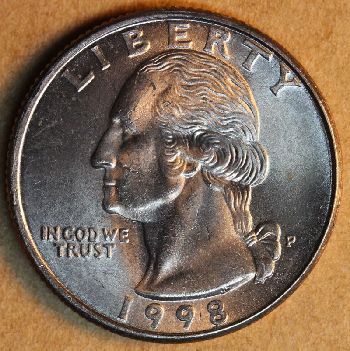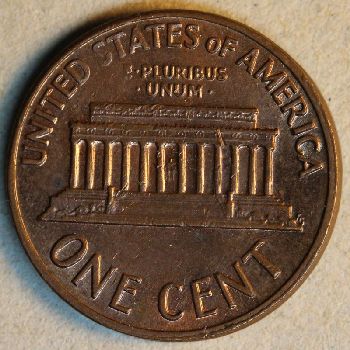Part VI. Striking Errors:
Die Alignment Errors:
Forced Misalignments
Definition: The term refers to misaligned die errors that can be linked to a specific circumstance or impact that delivered a vertical or horizontal force to the die. Forced misalignments are most often connected to horizontal misalignments of the hammer die.
- Collar clash. When a (temporarily) misaligned hammer die smacks into the beveled entrance the collar or scrapes down along the latter’s working face, it can push the die sideways in the opposite direction.
This 1998-P quarter displays a horizontal misalignment of the hammer (reverse) die toward the northwest. At the opposite pole, the design rim shows the characteristic serrations of collar clash. The impact of the hammer die against the collar could have nudged it in the opposite direction.
- Stiff collar error. When a slightly uncentered planchet is driven into a collar frozen in the “up” position, the shear forces transmitted through the planchet can nudge the hammer die sideways.
This 1997-P quarter features a stiff collar error in the southwest quadrant of the reverse face, which was struck by the hammer die. The hammer die is misaligned toward the northeast. The slightly uncentered planchet was driven all the way into a collar that was fully deployed and frozen in the “up” position. The shear forces generated at the site of the stiff collar error may well have nudged the hammer die in the opposite direction.
- Die attrition error. When a (temporarily) misaligned hammer die smacks repeatedly against the beveled entrance of the collar, the edge of the field portion of the die (and often the rim gutter) is worn away. The repeated impacts can drive the hammer die in the opposite direction.
This 1996 cent features (1) a die attrition error in the northeast quadrant of the obverse face, (2) a stiff collar error at the same location, and (3) a horizontal misalignment of the hammer (obverse) die toward the southwest. The repeated impacts of the hammer die against the beveled entrance of the collar wore away the field portion of the die so that the internal margin of the planchet’s cupped, unstruck crescent skirts the top of TRUST. These impacts probably nudged the die toward the southwest, aided by the shear forces generated by the stiff collar error.
- Indents and partial brockages. These can nudge a die sideways, especially when combined with a stiff collar. When an unstruck planchet or a previously-struck coin intrudes between the hammer die, an underlying planchet, and a fully deployed collar frozen in the “up” position, powerful shear forces are generated. These can nudge the hammer die sideways. While in-collar indents and partial brockages can be found in just about any location relative to a misalignment, they’re most often seen opposite the direction of movement.
This undated copper-alloy cent features a horizontal misalignment of the hammer (obverse) die toward the northwest. An in-collar indent is seen in the southeast.







